Eager to learn about the banjo? Wondering what makes a banjo ‘the best’? Well check out this guide to the banjo and all things banjo related as I’m sure I’ll try to answer any questions you’re sure to have. This is a complete starter guide to choosing the best banjo for your style, budget and skill level.
How to Buy a Banjo: Quick Overview
- Key factors to evaluate when choosing your first banjo.
- How sound quality, tonewood, and build impact your playing experience.
- Setup essentials: tuning, heads, strings and accessories you need.
- Common buyer mistakes and tips for buying a banjo.
This guide breaks it all down for you: what to look for, what to avoid, and how to find the right banjo for your style, skill level, and budget. Let’s start with the basics: what separates one banjo from another?
What to Look for When Buying a Banjo
Buying a banjo isn’t just about how it looks, it’s about how it sounds, feels, and fits your musical goals. Whether you’re starting your journey or upgrading, these are the key things to consider:
What kind of banjo should I get? A Four String, or a Five String Banjo?
Let’s start with the obvious. There is no such thing as the ‘best banjos’ for one thing. The reality is that the question you’re wondering is ‘which banjo is the best for me’? Well then, let’s start with the basics.
There are two types of acoustic banjos most commonly used in various styles of music today. These are the five string and the four string banjos. Now, you’re probably wondering ‘four or five strings? What kind of difference does one string make’? Well you’d be surprised. The simple answer is that these are two different styles of banjo, often used to play different styles of music and can be played in completely different ways.
Five string acoustic banjos are native to North America. They’re most commonly used to play various styles of folk, Country-Western, bluegrass, and are long enough instruments usually having 22 frets. The format of having five strings was designed specifically for playing bluegrass and Country-Western melodies, so the five string banjos are considered ‘better’ at playing American bluegrass than four string banjos are.
Both five string and four string banjos come in two distinct styles – open back or resonator. Both are great in their own respect, but resonator banjos have a cover (made from different kinds of wood) on the back of the body, projecting the sound of the banjo more. This in turn makes the tone shimmery and bright. In contrast, the open back banjos have a more mellow and softer tone. Each type has their advantages and disadvantages when it comes to playing and oftentimes comes down to the player’s personal preferences when picking one to play.
The four string banjo, specifically the Irish tenor banjo, is smaller in size and is considered the best banjo type to play traditional Irish music. Similarly though (and somewhat confusingly), plectrum banjos are also four string banjos and are more often used as a rhythm instrument playing chords instead of single notes, but more on that later.
Where Did the Banjo Come From?
Even though banjos are most commonly referred to as an American or Irish instrument, the roots of the banjo actually stem from Africa. A number of acoustic instruments from Africa shared a similar design: a frame made with a stick and a gourd covered, with an animal hide, and strings on top to produce sound. One particular instrument though, the ‘akonting’, thought to be the first prototype of the banjo was (and still is) made in central and western Africa.
However, it was brought to the U.S. through the slave trade and fluctuated in popularity over the years until eventually becoming a well known and played instrument. If you want to learn more about the history of the banjo, make sure to check out our blog post:
What’s an Irish Tenor Banjo?
Despite not being from Ireland originally, the banjo has made itself very well known in Ireland. Due to the very plucky, twang-like tone of its signature sound, the banjo has been famously adopted as a popular melody-playing Irish instrument. This is because the nature of its sound allows the banjo to be heard clearly even when played over instruments.
The Irish tenor banjo evolved from American four string banjos, and adopted the tunings of GDAE, CGDA, and DGBE. GDAE is the most common typical Irish tuning, and is the same tuning as a mandolin and a violin. CGDA, a fifth lower, is the same tuning as a viola and cello and is considered the ‘standard tenor tuning’. Since the range of these two tunings is wider than the DGBE counterpart, they’re often considered the best banjo tunings catered towards playing Irish music.
The DGBE tuning, also known as ‘Chicago tuning’, is quite unique. Following the format like the first four strings of a guitar, this tuning lends itself to anyone familiar with the guitar layout, or have played a five string banjo before, as this tuning is the same ‘Open G’ used on a five string without the actual fifth string.
Whether or not you pick one of these tunings, comes down completely to player preference as there are advantages and disadvantages with each tuning. The first two tuned in fifths have a wider range than the Chicago tuning, yet the Chicago tuning may be easier to play for those with guitar or five string banjo experience.
Standard Tenor Tuning

(Image from https://zinginstruments.com/how-to-tune-a-banjo/)
Irish Tenor Tuning

Plectrum Banjos
When Dixieland jazz started to emerge from New Orleans in the early 1900s, standard banjos started to change with it. Instead of being used as a solo instrument, they started to be used as an accompanying rhythm instrument. During this transition though, the fifth string was removed in order to play chords easier.
Eventually this version of the banjo was dubbed the ‘plectrum banjo’ as it was strummed like a guitar with a plectrum (a guitar pick). The high twang produced by the banjo helped its notoriety as it was able to cut through the sound of the brass instruments playing all of the melodies in a Dixieland jazz band.
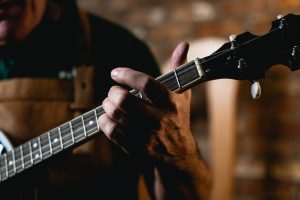
Taking Care of Banjo Heads
It’s always a good idea to look at our banjos to make sure they’re kept in the best condition possible. Since the body of a banjo is essentially a drum with strings attached, it begs the question ‘do I need to be changing the banjo head skin of the banjo body’? Well the good news is that unless you’re being particularly reckless with your banjos, most banjo heads tend to be quite durable and could last from anywhere from a couple of years to a few decades of use without needing to change it out. That being said, like a regular drum head, you should consider tuning the banjo body as well to ensure the banjo body sounds as incredible as it could be.
It’s also beneficial to know that if your banjo has an archtop tone ring, then you need a low crown height head. If the tone ring is a flathead though, then it needs a medium or high crown height head. With that said, different heads made from various materials will have different timbres. Some of the most common would be:
- Top frosted: crisp tone favoured by bluegrass players.
- Bottom frosted: favoured by the four string tenor banjos due to its deep and bass-like tone.
- Renaissance: honey coloured skin which gives the tone a bright touch and lots of sustain.
- Clear Head: thin and bright tone.
- Black Head: thicker and more mellow with lots of bass.
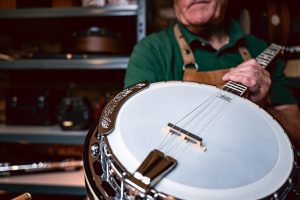
It’s important to note that certain factors such as the types of wood used to construct the banjo (such as curly maple or mahogany), the resonator rim-material used, whether or not it’s open back, as well as the type of banjo head, can heavily influence the type of sound that the banjo produces.
Banjo-Hybrids, What’s the Deal?
Over the years, the format of various banjos has been altered and changed in certain cases to mix both aspects of the banjo, and other string instruments. Not all banjos are acoustic, and some of these hybrids have become very popular in both studio and live settings. Some of these are:
- Banjitars (a.k.a. Guitjos, ganjos, six-string banjos): a six string version of a banjo tuned like a guitar. These instruments lend themselves well to any guitar players looking to dabble in the banjo sound without learning an entirely new instrument.
- Electric banjos: although not as unorthodox as other options such as the banjitar, some electric banjo models look pretty eccentric and can look quite different from their acoustic counterparts. Spanning from models that look like a regular banjo with a pickup, to models having a body that blends the standard circular resonator with an electric guitar-like aesthetic as well.
- Ukulele banjos (sometimes called a ‘banjolele): similar concept to the banjitar, a ukulele banjo is a mini banjo with four strings tuned to a ukulele’s tuning of GCEA.
- Mandolin-banjos: certainly less common than the banjo-ukuleles, a mandolin-banjo as the name implies is an eight string instrument tuned akin to a mandolin but using a banjo resonator or open back body instead.
Snapped a String? No Need to Panic
Like all stringed instruments, the strings in a banjo need to be changed every so often for fresh ones to keep the tone and feel of the instrument at its peak. Changing strings also helps reduce the chance of snapping a string as well, which as we all know, can bring a lively trad session to an abrupt end (which is certainly not what we want).
How Often Should I Change Banjo Strings?
String age affects tone and tuning stability. Just like the guitar for example, ideally you should change your banjo strings every three months or so, but this may fluctuate depending on how much you’re practising. If you’re only playing for a couple minutes a day, your strings will last almost forever, but if you’re absolutely battering your banjo and playing for hours on end regularly, then the strings might need to be changed sooner.
Also, pro tip: restringing your banjo a few days prior to a gig reduces the chances of snapping a string by a substantial amount!
Essential Accessories for Your New Banjo
Once you’ve chosen your banjo, the right accessories will elevate your playing experience; from comfort and tone to tuning stability and protection. Here are the essentials we recommend for every player:
Case: McNeela Padded Gig Bag, protect your instrument on the go.
Tuner: McNeela Digital Clip-On; accurate, fast tuning anytime.
Strap: Adjustable Banjo Strap; play comfortably, seated or standing.
Picks: Thumb & finger picks – Especially helpful for bluegrass and fingerstyle playing.
In short: a banjo that sounds good, feels good, and stays in tune is the one you’ll keep coming back to.
Want to dive deeper into banjo gear? Explore our banjo accessories.
Banjo Sound, Build & Materials
The way a banjo is built has a huge impact on how it sounds and feels. These are the things that make the biggest difference:
Tonewoods: When it comes to tonewoods, each one shapes the banjo’s voice in a different way. Maple gives you a bright, punchy sound that works especially well for bluegrass. Mahogany leans toward a warmer, mellower tone, ideal for folk and old-time styles. And walnut sits right in the middle, offering a balanced mix of brightness and warmth.
Tone Rings: A banjo’s tone ring makes a noticeable difference to its voice. Models without a tone ring offer a softer, more old-time character, while rolled brass adds a little extra sustain and clarity for a more defined sound. Cast bronze delivers the brightest, loudest and most powerful response, which is why it’s the choice many professional players prefer.
Build Quality: Look for clean craftsmanship: a straight neck, even frets, a smooth finish, and solid hardware. These details affect tuning stability and overall comfort.
Open-Back vs. Resonator: Resonator banjos project the sound outward, giving you a louder, brighter tone: great for bluegrass or playing with a band. Open-back banjos are quieter and warmer, ideal for clawhammer, folk, and solo playing.
Want to compare all banjo types and their sounds? Explore Types of Banjos Explained.
So, What kind are Considered the Best Banjos?
Well, there’s no specific answer to which banjo type is the best, as it’s completely subjective. However, there are certain things you might want to consider when it comes to what kind of music you want to play. The tunings and format of five string banjos are great to play a lot of Country and bluegrass music as I’ve mentioned. While on the other hand, the four string tenor banjo’s simplicity makes playing chords much easier, and the tunings have a much wider range than the typical five string tuning.
That being said, none of these rules are set in stone and banjos can be used as very versatile instruments. There are many musicians who play and have played all sorts of genres with all sorts of different banjos. What’s most important is what banjo is best for you at the end of the day.
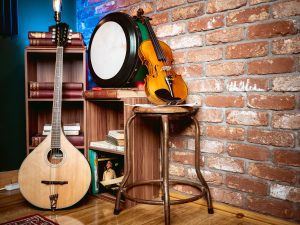
In short, what makes a good Banjo?
A “good banjo” isn’t just expensive , it’s well-balanced in:
Sound quality (resonance, tone, volume).
Playability (comfortable neck, action height, fret spacing).
Build durability (materials, hardware, finish).
Before you buy, check for:
When you’re trying to buy a banjo and want to make sure you’re choosing from the best banjos, focus on the fundamentals: premium tonewoods like curly maple, mahogany, or walnut; reliable hardware such as good tuning pegs, a solid tailpiece, and a well-built bridge; proper head tension; and a smooth finish with a straight, comfortable neck. These details are what truly separate the best banjos to buy from the rest.
Tip: If you’re unsure, try the banjo in-store or ask for setup help. The right fit can completely change how it feels and sounds.
Interested in Picking Up a Banjo Yourself? Check our Online Store for Top Quality Options!
We have a plethora of great top-quality banjos available at our shop here at McNeela. Our range spans from classic 5 String Banjos, to our famous Irish Tenor Banjos and everything in between! We also sell a wide variety of other stringed acoustic instruments suitable for session gigging, or studio use such as: guitars, violins, bouzoukis, mandolins, ukuleles, harps, and many more. All of these are made from incredible high quality materials, at affordable prices, promising to suit your every need.
What to Avoid When Buying a Banjo
– Buying a banjo with poor tuning stability: “I bought the cheapest one on Amazon… don’t do that,” said one player. It’s something I hear all the time. A stable instrument is essential; otherwise, you’ll be tuning more than playing.
– Ignoring your music style: One of the biggest mistakes? Choosing a banjo that doesn’t suit your style. A folk-punk player will want something very different from a bluegrass picker.
– Choosing a size that’s uncomfortable for your hands: One of the most common complaints we hear in-store: “I didn’t realize how heavy this banjo would be.” Always try to match the neck profile and weight to your playing comfort.
– No expert setup: So many players come in with banjos from big box stores that just don’t sound right. Almost always, it’s down to poor factory setup. A good setup makes all the difference.
– Mixing up tenor and plectrum models: They look similar, but they’re not interchangeable. Make sure you’re picking the right one for your music.
If you’re looking for more information on banjos in general, or any other aspect of Irish music, be sure to check out our many different blog posts all about our instruments.
- What’s the Difference Between a 5 String Banjo and a 4 String Banjo?
- Types of Banjos Explained
- Best Beginner Banjos
- How much does a Banjo cost?
- Cheap Banjos Under $500
- Top Banjo Brands to Know
- Where to Buy a Banjo: Online vs In Store
Common Questions Before Buying a Banjo
What is the best banjo to buy as a beginner?
The best beginner banjo is one that suits your musical goals and feels easy to play from day one. For Irish trad, a 17 or 19 fret tenor tuned GDAE works best. For bluegrass or folk, start with a simple 5-string resonator or open back. Focus on stable tuning, a clean setup and a tone that inspires you to keep practicing.
Is it better to buy my first banjo online or in store?
Both options work well. Buying in store lets you feel the weight and try different necks. Online shopping offers more choice when done through a specialist that provides setup, warranty and clear support. Look for a retailer that checks every instrument before shipping and offers hassle-free returns.
How much should I spend on my first banjo?
A good beginner banjo usually starts around $500 (≈ €450). At this level, you get stable tuning, a clean setup and a tone good enough to keep you motivated. Cheaper instruments may seem tempting but often cause frustration. Choose a solid, well-set-up model that supports steady improvement.
What’s the warranty on McNeela banjos?
Every banjo comes with a 1-year warranty covering parts and craftsmanship. We also offer fast, responsive support if you need assistance post-purchase.
What should I avoid when buying a banjo?
Avoid very cheap models with sharp frets, unstable tuning or high string action. These issues make learning uncomfortable and slow your progress. Be careful with no-name instruments that offer limited details about materials or setup. Choose a banjo from a trusted shop that checks playability before shipping.
How do I choose the right banjo for my style?
It starts with the music you want to play. Tenor banjos suit melody-focused Irish playing, while 5-strings work best for bluegrass rolls, clawhammer or modern folk. Open backs offer a warm sound for solo practice, while resonator models give bright projection for groups. Match the banjo’s tone to the style you love.
What kind of banjo is best for Irish music?
The Irish tenor banjo, hands down. It’s tuned GDAE (same as fiddle/mandolin), making it perfect for melody playing in traditional sessions. See our full Irish Tenor Banjo Guide for tuning tips, top picks, and playing advice.
I’m an experienced player. What type of banjo should I choose for upgrading?
If you’re ready to upgrade, look for handcrafted models with tone rings, premium woods like maple or mahogany, and advanced setups. Our Irish tenor and 5-string banjos are crafted to meet the needs of serious players — whether you're performing, recording, or just looking for that next-level tone.

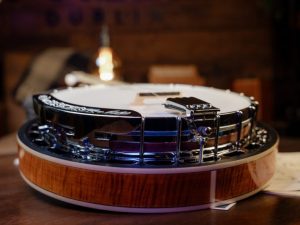
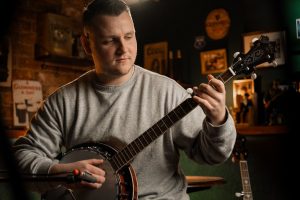

![How Much Does a Banjo Cost? [2025]](https://blog.mcneelamusic.com/wp-content/uploads/2025/10/Gemini_Generated_Image_6z9ni96z9ni96z9n-300x171.png)



Share your thoughts
Thank you for all the information on banjos. I have one question. What would you recommend for an 8year old ready to learn banjo for traditional irish music but also has a nice warm sound and is good quality ? Looking forward to hearing your opinion.